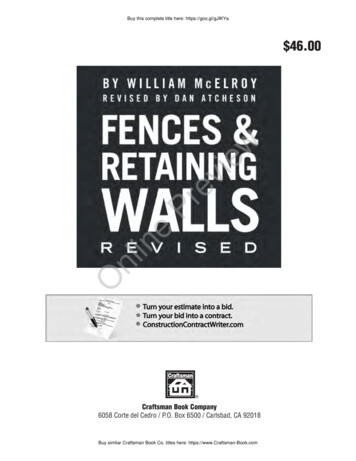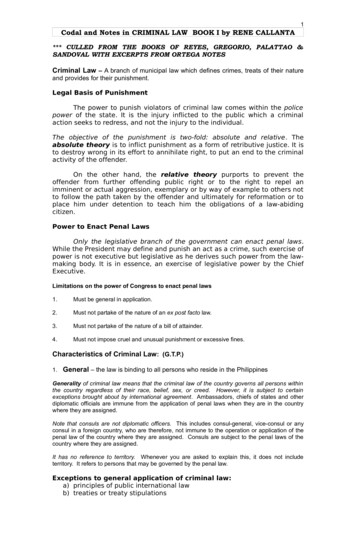
Transcription
Fences andthe Law
Fences and the LawThis information is a general guide to the law. It is not a substitutefor legal advice. Contact the Legal Services Commission, acommunity legal centre or a private lawyer for detailed advice.October 2020 Legal Services Commission, South Australia2
Fences andfencestheandLawthe lawpage 2Talk to your neighbour first!2Do I need my neighbour’s consent?2Must we have a fence?2What is fencing work?3What kind of fence?3Where should the fence be?3How is the cost of fencing work shared?4What if we agree?4What if we can’t agree?4The Fences Act procedure5How do I get my neighbour to pay?5Notices6Objections and counter proposals6No agreement8Taking the case to court8Failure to proceed9Power of entry9Paying for fencing work9Other considerations10Railings10Council approval10Brush fencing10Land under contract10New housing developments10Absent or unknown owners10Rental properties11Dogs11Emergency repairs11Damage12Retaining walls12Guide to forms14Contacts20
FENCES AND THE LAWTalk to your neighbour first!This booklet answers common questionsabout dividing fences and explains thelegal procedure you need to follow whenyou want to erect, replace or repair aboundary fence. While the legal procedureis important, so are good neighbourlyrelations. So, before starting the legalprocedure, talk to your neighbour first.Whatever you do about a fence will affectthem also. A friendly approach may helpyou to reach an agreement quickly andeasily and avoid unnecessary conflict.Do I need my neighbour’sconsent?Fences should be regarded as a jointasset between neighbours. Even if yourneighbour has not paid for the fence theyare still a joint owner. This is becausea fence on the boundary is legallyconsidered to be part of the land oneach side.If you intend to remove or alter an existingfence, you should have your neighbour’spermission or a court order. If you want toput up a fence where there has not beenone before, your neighbour has a rightto object. It makes no difference if youintend to pay the total cost. It is thereforesensible to talk to your neighbour first.2Also, your neighbour does not have to payanything towards the fencing work unless: they have agreed to, or the proper procedure has beenfollowed, or a court orders them to.Getting their consent is the quickest andeasiest way.If there is a problem in getting yourneighbour’s consent, consider mediation.Your local community mediation servicemay be able to arrange a meeting foryou both to discuss the options witha mediator who can help you to reachagreement. See page 20 for more details.Must we have a fence?There is no general law requiring a fencebetween neighbours; most people simplyagree to have one. However, the courtsgenerally consider it reasonable to have afence and to keep it in good condition.In particular cases, a fence can be legallyrequired. Some examples are: some housing developments haverestrictive covenants controlling fencing swimming pools must be fenced dog owners have a duty to prevent theirdogs wandering at large, so if the doggoes outside, the yard must be fenced fencing may be required as a conditionof council planning approval.
FENCES AND THE LAWThe wall of a building is not legally definedas a fence, though if it is on a boundary itmay make one unnecessary. If the buildingis removed, the owner is not necessarilyobliged to fence the gap.Obviously, neighbours may disagree aboutwhat sort of fence is adequate for them. Theremay be several adequate options. Talk to yourneighbour and try to agree on a fence thatsuits you both.What is fencing work?Where should the fence be?Fencing work is defined as the erectionof a new dividing fence, or replacement,repair or maintenance work in relation toan existing dividing fence. The cost caninclude any work reasonably required tofacilitate fencing work such as a survey orclearing vegetation. If you do any of thefencing work yourself, you can include areasonable amount for your labour.The fence should be on the boundary, butin practice, many fences are not preciselyon the boundary. This does not change whoreally owns the land and need not matter ifboth neighbours can accept it.What kind of fence?The courts decide what kind of fence isneeded by looking at what is an “adequatefence”. This means a fence that is typical ofgood fencing in your area and is adequatefor the purposes of the owner againstwhom contribution is sought (FencesAct 1975, s12 (8)(a)). In rural areas, postand wire fencing may be adequate, butin residential areas, a steel (Zincalume orColorbond) fence is usually consideredadequate.Where residential blocks adjoin farmingblocks of more than 0.8 hectares, anadequate fence is the cheaper of thefarming and residential fencing options. If aresidential type fence is proposed, the farmerdoes not have to contribute more than theirfair share of a fence suitable for primaryproduction purposes.Whether or not it is precisely on theboundary, a dividing fence is still the legalresponsibility of both neighbours. However,if there is a dispute about where a fenceshould go, get a survey done which willshow exactly where the boundary is. If youboth want the survey, you can agree toshare the cost, but if not, the person whoarranges the survey will have to pay for it.Under a Fences Act notice, a survey can beincluded as a cost of the proposed fencingwork. However, your neighbour may objectto paying for a survey if they believe it isnot necessary. If they object and it goes tocourt, a Magistrate will have to decide if asurvey is reasonably required.If necessary, a court can order the removalof a fence that is not located on the properboundary and this can be expensive.However, a court is unlikely to order therelocation of a fence if the diversion fromthe boundary is minor.3
A court can order that compensation be paidto a person for the loss of occupation of landas a result of the erection of a fence not onthe boundary.Generally, a fence should straddle theboundary line, but a masonry fence, whichmay be wider, should usually be on theland of the person who wants it, with theouter face on the boundary.How is the cost of fencing workshared?Usually, the cost is shared half each,though you can agree on some otherarrangement. It really depends on thebenefit that each owner will obtain fromthe fence. Where one neighbour wants abetter than adequate fence, for exampleif they want a high fence where a lowerfence would do, or a brush fence wheresteel sheeting is adequate, they shouldpay the extra cost. This might be adjusteda bit for any benefit the other neighbourgains, for example, extra privacy. If thecase goes to court, the court will normallyorder that the objecting neighbour pay halfthe cost of a fence that is adequate.Where two blocks of land abut a publicroad, the owner of land across the roadcan be asked to contribute to the costof a fence if it also benefits them. Forexample, if the owner has stock animalsand their neighbour’s fence saves themthe expense of erecting a fence on theirside of the road.4Of course, the cost of a fence betweenneighbours is only shared if you have agreedon this, or followed the proper procedure. Ifyou have gone ahead without doing this, youpay the whole cost.What if we agree?If you and your neighbour agree on thework and the cost-sharing, you do nothave to follow the procedure under theFences Act. However, even if you do notfollow the procedure, it is wise to make awritten agreement, signed by both of you.It should state clearly what work is to bedone, what materials will be used, whatquotes have been accepted, and howthe cost will be shared. An example of anagreement is on page 18. Attach copiesof quotes for all work. A clear, signedagreement should spell out what wasagreed to - without it you could still end upin court.What if we can’t agree?If you can’t agree, try mediation first. Thiscan be cheaper and quicker than court,and can help preserve a good neighbourlyrelationship. However, if this does notwork, or your neighbour will not take part,you will need to follow the Fences Actprocedure, unless you decide to abandonthe fencing work, or to pay for it all yourself.Even if you pay the whole cost you shouldstill get their permission before doing thework. A court may order a person whoremoves a fence without permission torestore the original fence or alter the newfence if it does not suit the neighbour.
FENCES AND THE LAWIf you and your neighbouragree on the work andthe cost-sharing, youdo not have to followthe procedure under theFences Act. However, evenif you do not follow theprocedure, it is wise tomake a written agreement,signed by both of you.The Fences Act procedureHow do I get my neighbour to pay?Much of the law about fences is in the FencesAct 1975. It applies to the fencing of all land,including vacant land, developed land, andrural properties, except for government orcouncil land more than one hectare in size, orland forming a road or reserve. It applies toall kinds of fences, but not to retaining wallsor the walls of buildings.If you and your neighbour don’t agree, youmust use the Fences Act notice procedure.It is the only legal method if you want tobuild, repair or replace a boundary fence andyou want your neighbour to contribute tothe cost, but they don’t agree. The processinvolves filling in a form (called a notice) withdetails of the work you propose and servingit on (legally delivering it to) your neighbourfor response. This booklet contains noticeforms which you can use. Your neighbourdoes not have to contribute unless youfollow the procedure correctly.However, the Fences Act does not contain allthe law about fences. Common law, privatecontracts, planning regulations and otherlaws may apply. It also does not deal withencroachments, where one person’s buildingis partly on another person’s land – theseare dealt with under the Encroachments Act1944. Legal advice should be sought in thissituation.5
NoticesIf you want to put up a new fence and wantyour neighbour to contribute, you mustserve on the adjoining owner a ‘Notice ofIntention to Erect a Fence’ using Form 1on page 15.If you want to repair, replace or carry outmaintenance work on the fence and wantyour neighbour to contribute, you mustserve a ‘Notice of Intention to Replace orRepair a Fence’ using Form 2 on page 16.All notices must be served on theadjoining owner either by handing themto the owner personally or by sendingthem by Registered Post.Leaving it in their mailbox, putting it underthe door or sending it by ordinary post doesnot count, even if your neighbour actuallygets it. Similarly, giving it to someone elsewho lives there, or a family member ortenant of your neighbour does not count.If you are not sure who the legal owner is,you can ask your local council or search atthe Lands Titles Office. If there is more thanone owner, you must put all their nameson the notice. Keep a copy of any noticeyou serve, and also a record of the date,time and method of service, in case yourneighbour later says they did not get it.Once the Form 1 or 2 notice has beenserved on the land owner, you must wait 30days before starting any work. In this timethe other owner may object with a crossnotice, which may include counterproposals.This cross-notice should be the Form 3 onpage 17.6If the adjoining owner agrees with theproposal, work can commence immediately,but you should get their agreement in writingor else wait for the 30 day notice period toexpire. See the sample agreement on page 18.If you get no reply from the other ownerafter 30 days, they are taken to haveagreed and you can go ahead with thework described in the notice and claimtheir share of the cost from them. If yousent the notice by Registered Post, checkwith the post office to see when yourneighbour actually collected the notice.You should allow 30 days from that dateand also give at least two days notice ofintention to commence fencing work.Objections and counter proposalsIf you receive a Form 1 or 2 notice andyou object to the proposal, you shouldcomplete a Form 3 cross-notice (see page17). This cross-notice must be served onthe adjoining owner within 30 days ofreceiving the fencing notice. The samerules of service apply as above.You do not have to give reasons forobjecting - you may simply state “I objectto your proposal”. Nor do you have to makea counter-proposal. However, if the casegoes to court you will be required to tellthe court your objections to the proposedwork, and if you do not have good reasons,the court may order the work, and mayalso order you to pay court costs. So, ifyou have good reasons, it makes sense tostate them in your cross-notice.If you want to suggest something different
FENCES AND THE LAWfrom what your neighbour has proposed, youshould do so, giving details of the work andthe cost. Your neighbour then has 30 days toanswer your notice.It is not a sufficient objection for across-notice that you are about to sellyour land and will not get the benefit ofthe proposed work. As long as you are theowner, the Fences Act procedure bindsyou. However, you may wish to let yourneighbours know that you are selling, asthey may agree to wait and deal with thenew owner. Nor is it reasonable to objectto fencing simply because you are notliving at the place where the fence is tobe built.An inability to afford the work issometimes the reason for an objection,but this will not stand up in court,particularly if the fence is in a poor stateand the work is obviously needed. If youagree that the work is required but youcannot afford to pay for it at this time, youshould discuss terms of payment withyour neighbour. If you cannot agree ona solution, consider using a mediationservice. See ‘Paying for fencing work’on page 9.Other reasons that are not acceptable in courtinclude that you don’t care about the stateof the fence, or don’t think a fence is needed.The court normally considers it reasonablefor neighbours to have a boundary fence
Fences Act. However, even if you do not follow the procedure, it is wise to make a written agreement, signed by both of you. 6 Notices If you want to put up a new fence and want your neighbour to contribute, you must serve on the adjoining owner a ‘Notice of Intention to Erect a Fence’ using Form 1 on page 15. If you want to repair, replace or carry out maintenance work on the fence and .File Size: 345KBPage Count: 24











